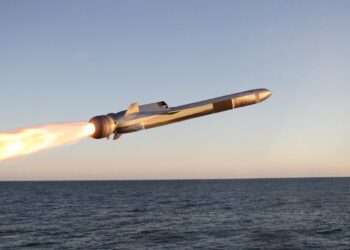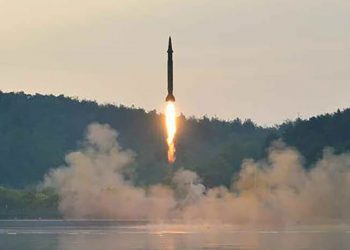Lockheed Martin,
BETHESDA: Lockheed Martin-developed missile defense system elements led global ballistic missile defense efforts in 2008 with five successful target intercepts, including two international intercepts, and numerous next-generation milestones. With proven hit-to-kill technologies and demonstrated reliability, Lockheed Martin has firmly-positioned each phase of missile defense – boost, midcourse and terminal – to support the U.S. Missile Defense Agency's (MDA) layered Ballistic Missile Defense (BMD) System and allied nations' requirements in 2009 and beyond.
Lockheed Martin's unparalleled BMD hit-to-kill intercept record includes 16 successful Aegis BMD intercepts, five successful Terminal High Altitude Area Defense (THAAD (TM)) intercepts and 16 successful Patriot Advanced Capability-3 (PAC-3 (TM)) intercepts since 2001.
“Lockheed Martin-developed weapon system elements and critical technologies continue to protect our great nation and its international allies against ballistic missiles, cruise missiles, aircraft and other airborne threats,” said John Holly, Lockheed Martin vice president of Huntsville Operations. “The Lockheed Martin team is working with the MDA to develop and prove, through rigorous testing, next-generation systems that answer challenges presented by the very real threats we face today and the even more challenging threats we will face in the future.”
Lockheed Martin's many operational systems and next-generation capabilities have demonstrated consistent reliability and illustrate the progress being made in support of a strong layered missile defense.
2008 Missile Defense Milestones:
ABL
– In November, the MDA's Airborne Laser (ABL) team successfully fired the High Energy Laser for the first time through the Lockheed Martin-developed Beam Control/Fire Control System. In ground tests in the ABL aircraft at Edwards Air Force Base, CA, the system focused and directed the beam through the aircraft's conformal window into a range simulator. Further testing of the boost-phase ABL system will culminate in an airborne intercept test against a ballistic missile in 2009.
AEGIS
– In January, Lockheed Martin received a $40.4 million contract modification to equip the Japanese JS Myoko with Aegis BMD capabilities. The JS Myoko is the third of four Japanese destroyers scheduled to receive Aegis BMD capabilities. The JS Kongo and JS Chokai are already at sea and operational with Aegis BMD. Aegis BMD is the primary component of the sea- based element of the United States' BMD System. The Aegis Weapon System, upon which Aegis BMD is based, is the maritime weapon system of choice for the United States, Japan, South Korea, Norway, Spain and Australia.
Aegis Open Architecture was installed on USS Bunker Hill as a key component of the Navy's Cruiser Modernization Program. Using commercial off-the-shelf computing hardware and open system software, the Aegis Open Architecture provides easy integration of technology refreshes and capability upgrades that will keep the technology leading-edge. This milestone in Aegis Open Architecture is part of the development path to merge Aegis Open Architecture and Aegis BMD in 2012, when the Aegis Modernization program begins for the Navy's 62 Aegis-equipped destroyers.
The Aegis system's second successful terminal phase endo-atmospheric intercept, in June, set the tone for the test and evaluation of the latest version of Aegis BMD – Aegis BMD 3.6.1 – leading to full certification in November. The new system will be installed in all 18 U.S. Navy Aegis BMD ships by June 2009.
In a one-time emergency mission, Lockheed Martin modified the USS Lake Erie's Aegis BMD Weapon System to successfully intercept an errant U.S. satellite in the exo-atmosphere in February. The Aegis system prevented the satellite from re-entering the Earth's atmosphere in an uncontrolled and dangerous manner by guiding an interceptor from the MK 41 Vertical Launching System to the terminal phase of intercept.
HAA
– Earlier this year, Lockheed Martin's High Altitude Airship (HAA) program transferred from the MDA to the U.S. Army Space and Missile Defense Command (USASMDC), located at Huntsville, AL. With this program transfer, the USASMDC is continuing the development and demonstration of the HAA to align with the USASMDC mission. The HAA effort is a spiral development program for a family of long-endurance autonomous solar-electric, stratospheric airships that is recoverable for reuse.
The HAA technology is available now and ready for integration and flight test. The first phase of HAA spiral development is the High Altitude Long Endurance Demonstrator (HALE-D). The HALE-D will demonstrate the feasibility of controlled high altitude lighter-than-air flight while carrying a payload for a duration of two weeks. The HALE-D is scheduled for flight test the summer of 2009. The HAA will integrate multiple payloads to address multiple missions at a cost of 1 to 2 orders of magnitude less than any other airborne platform.
MEADS
– In January, Lockheed Martin was awarded a $66 million contract to incorporate the PAC-3 Missile Segment Enhancement Missile into the Medium Extended Air Defense System (MEADS). PAC-3 will serve as the tri-national program's baseline interceptor.
In February, MEADS completed its system Preliminary Design Review. The MEADS international team is now preparing for the 2010 Critical Design Review.
MKV
– Lockheed Martin successfully conducted a free-flight hover test of the MDA's Multiple Kill Vehicle-L (MKV-L) December 2, the first of several tests to prove readiness for flight testing aboard midcourse interceptors. Performed at the National Hover Test Facility at Edwards Air Force Base, CA, the test represented a major step forward for the earliest operational payload designed to destroy multiple threat objects with a single missile defense interceptor. Earlier in the year, Lockheed Martin successfully demonstrated engagement management algorithms, tested a divert thruster and calibrated an infrared sensor.
PAC-3 Missile
– In September, the first international PAC-3 Missile flight test was successfully performed by the Patriot Japan Self Defense Force at White Sands Missile Range, NM. The Japanese PAC-3 Missile used hit-to-kill technologies to successfully detect, track, intercept and destroy a tactical ballistic missile target in a realistic battlefield environment.
The following month, Lockheed Martin supported a second international PAC-3 Missile flight test with the Airmen of the German Air Force (Luftwaffe). It was the first time a German PATRIOT launcher executed a PAC-3 Missile launch. Both the Japanese and German systems flew with Patriot Configuration-3 upgrades.
Early in the year, Lockheed Martin was awarded contracts totaling $556 million from the U.S. Army Aviation and Missile Command for hardware and services associated with the combat-proven PAC-3 Missile program. The PAC-3 system has successfully intercepted 22 out of 25 targets since testing began in the mid-1990s.
In December, Lockheed Martin received additional contracts totaling $774 million from the U.S. Army for the PAC-3 Missile program. These contracts include fiscal year 2009 missile production for the U.S. Army as well as the first sale of the PAC-3 Missile Segment to the United Arab Emirates.
SBIRS
– In December, the first Space Based Infrared System (SBIRS) Highly Elliptical Orbit (HEO-1) payload and ground system, built by a Lockheed Martin team for the U.S. Air Force, was certified for operations by U.S. Strategic Command. The formal certification completed the system development, operational activation and certification process, demonstrating the capability of the SBIRS HEO sensor and associated ground system to provide timely, accurate missile warning data to the Warfighter. SBIRS is designed to provide early warning of missile launches, and simultaneously support other missions including missile defense, technical intelligence and battlespace awareness.
Last year the SBIRS team achieved key integration and test milestones on the first geosynchronous orbit (GEO) spacecraft, including a comprehensive acoustic and pyroshock test regimen that validated the overall satellite design, quality of workmanship and survivability during space vehicle launching and on-orbit operations. Thermal vacuum testing of the completed GEO-1 space vehicle, which will validate its performance at temperature extremes greater than those expected during on-orbit operations, is planned for 2009 in preparation for delivery to the U.S. Air Force in fiscal year 2010.
TARGETS AND COUNTERMEASURES
– Under the MDA's Targets and Countermeasures Prime Contract, Lockheed Martin successfully launched three target missiles in 2008 – one for the June 5 test of the sea-based Aegis BMD system, one for the June 25 test of the THAAD system, and one for the November 19 test of the Japanese Aegis system. Since its first prime contract mission in 2005, Lockheed Martin has achieved 13 successes in 14 missions. Including targets provided prior to the prime contract, Lockheed Martin has achieved a 97 percent mission success rate, with a total of 30 successes out of 31 missions since 1996.
In 2008, Lockheed Martin also validated the new “ship and shoot” approach, under which each target vehicle will be fully-integrated prior to shipment to the test range, and completed most of the flight hardware and integration for the first mission of the next-generation Flexible Target Family.
THAAD
– In May, the U.S. Army activated its first THAAD battery at Fort Bliss, TX. In preparation for full-system fielding in 2009, the Alpha Battery/4th Air Defense Artillery Regiment was unit-trained on THAAD equipment.
In June, THAAD achieved its first successful intercept of a separated target in the mid endo-atmosphere. The separated target represented a new target class over the unitary targets previously used, and the test successfully demonstrated the system's ability to detect, track, discriminate, and intercept against separated targets. THAAD has achieved nine for nine successful flight tests since 2005.
Lockheed Martin plays a critical role in the nation's layered air and missile defense system being used today. In addition to operational defenses, Lockheed Martin provides the backbone systems that integrate the sensors, command and control, and weapon system elements of the ballistic missile defense system. The corporation also is focused on next-generation capabilities and provides targets and other methods to test system elements.
Lockheed Martin is a world leader in systems integration and the development of air and missile defense systems and technologies, including the first operational hit-to-kill missile defense system. It also has considerable experience in missile design and production, infrared seekers, command and control/battle management, and communications, precision pointing and tracking optics, and radar and signal processing. The company makes significant contributions to major U.S. missile defense systems and participates in several global missile defense partnerships.
Headquartered in Bethesda, Md., Lockheed Martin is a global security company that employs about 140,000 people worldwide and is principally engaged in the research, design, development, manufacture, integration and sustainment of advanced technology systems, products and services. The corporation reported 2007 sales of $41.9 billion.









